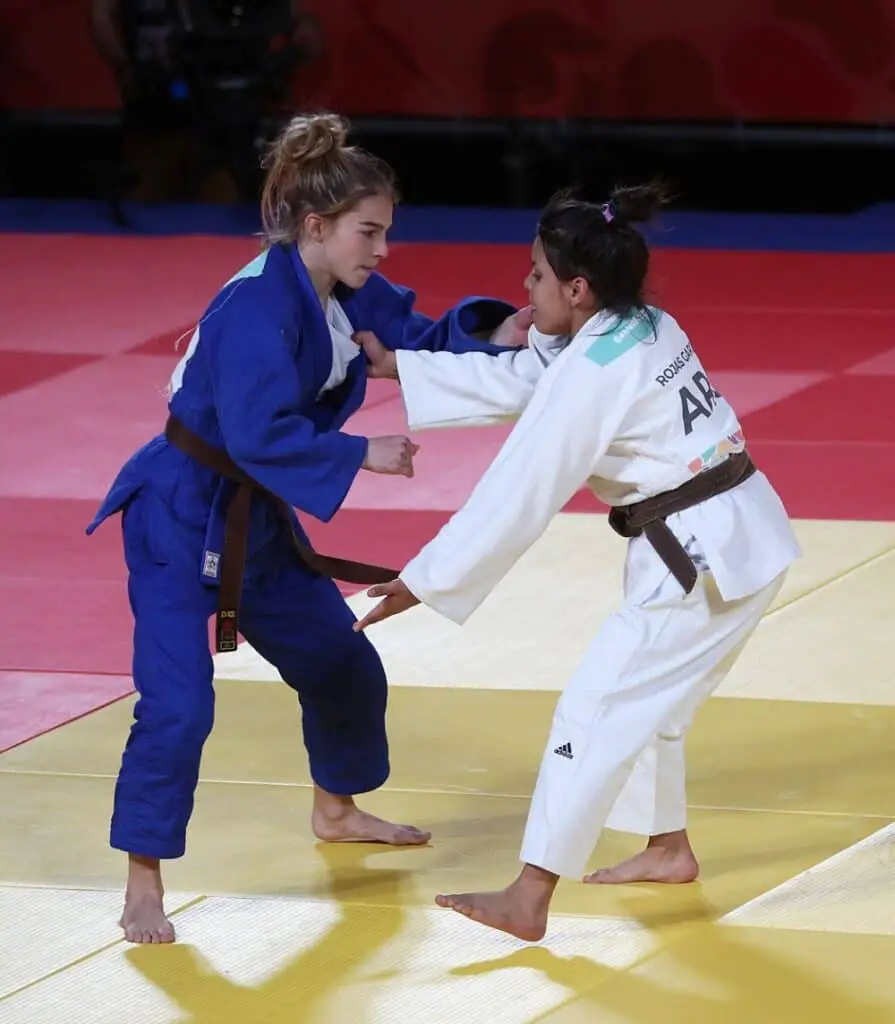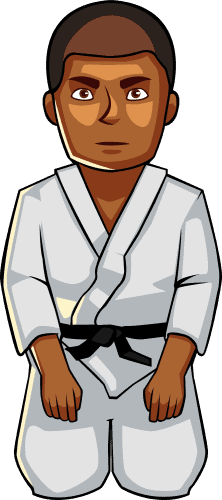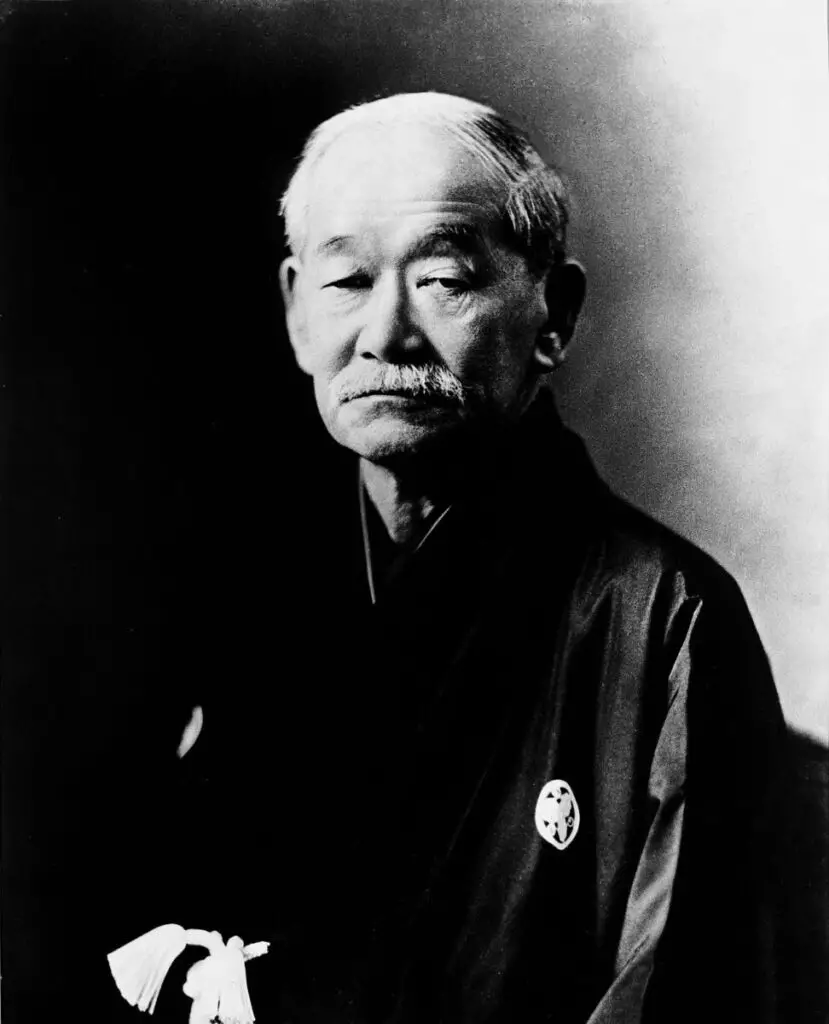
If you’re interested in enrolling your child in a martial arts class, you’ve probably noticed that there are a lot of different martial arts to choose from. Brazilian Jiu Jitsu (BJJ) and Judo are two popular choices of martial arts for kids. To decide which would be the better choice for your child, you’ll need to know more information about each martial arts style.
Brazilian Jiu Jitsu is the best choice for self defense for a child being accosted by one person in a one on one confrontation. Judo teaches defensive skills that can apply to one or multiple assailants. Judo also incorporates character development, integrity, and honor in its training.
While both Brazilian Jiu Jitsu and Judo have many similarities, there are some key differences that can impact which one of the martial arts will be most suitable for your child. Read on to arm yourself with all the information you’ll need to make the right decision for you and your family.
If what you are looking for is not the best grappling style for your child, but what is the most FUN martial art for kids, you should check out my article here.
Contents
- Brazilian Jiu Jitsu Teaches Self-Defense for Real World One to One Confrontations
- Judo Combines Mental and Physical Fitness And Usable Multi-Attacker Defense
- Consider the Martial Arts School When Choosing Between BJJ and Judo
- Choosing Between Brazilian Jiu Jitsu and Judo for Kids
- BJJ or Judo? It Depends on Your Goals for Your Child
Brazilian Jiu Jitsu Teaches Self-Defense for Real World One to One Confrontations

Because Jiu Jitsu originated from the newaza of Judo, it emphsizes the controlling aspect of ground grappling. This in history can be traced through Judo back to samurai looking to protect themselves in the event that they lost their weapons. Controlling an armed opponent took precedence over punches or kicks.
A samurai would typically be fighting another armored person like himself so it wouldn’t make the most sense to try to hit or kick someone covered in armor. For that reason, the samurai studied Jiu Jitsu and the different techniques for throwing their armored opponents to the ground and controlling them instead.
Brazilian Jiu Jitsu Students Learn Ground Grappling Techniques
If you want to get your child involved in martial arts but you are hesitant because you worry it may be too dangerous, Brazilian Jiu Jitsu may be a good fit. Rather than selecting a martial art that focuses on striking, choosing a style that teaches ground fighting techniques will offer not better, but maybe safer self-defense skills. Avoiding strikes from an opponent is a crucial self-defense method and this strategy is a core part of Brazilian Jiu Jitsu.
Brazilian Jiu Jitsu employs many grappling and ground fighting techniques that would transfer well to a real-life situation requiring self-defense skills. Many other forms of martial arts don’t teach ground fighting techniques which puts the students at a disadvantage in one on one altercation.
Kids Practicing Brazilian Jiu Jitsu Learn How to Adapt to Many Attack Scenarios
Brazilian Jiu Jitsu teaches you how to adapt to many situations. There are more techniques taught in this style of martial arts that better prepare students for one on one situations they may encounter. In the event of an attack, being trained in Brazilian Jiu Jitsu gives the victim an edge since they can respond quickly and adapt to whichever method of attack is being used against them.
Jiu Jitsu students learn how to fight in many different scenarios, incorporating a variety of techniques that can be executed in situations where:
- They are face to face with an attacker in close range
- They are face to face with an attacker out of arm’s reach
- They are attacked from behind
- They are knocked to the ground during an attack
Many other sport forms of martial arts like boxing and wrestling don’t account for going up against an opponent of superior size or physical fitness. With the techniques learned from Brazilian Jiu Jitsu, your child would be more prepared to defend themselves against a larger assailant.
BJJ empowers students by showing them how to escape from or reverse a position to give themselves the upper hand, such as when an opponent has them in a headlock or chokehold, attacks them from behind, or has them on the ground.
Protecting the head is of the utmost importance for self-defense and Brazilian Jiu Jitsu teaches students how to do so. Some forms of martial arts like TaeKwonDo teach stances where the student’s arms are at their sides which leaves them open to a strike in the head region. In both Judo and Brazilian Jiu Jitsu, the students will learn how to keep their guard up when sparring with an opponent and wait for opportunities to grapple.
A Brazilian Jiu Jitsu class covers a variety of skills during each session. Students will practice how to employ a hold on their opponent, as well as how to get out of a hold. They practice different fight scenarios both standing and on the ground. The teachers come up with many different scenarios to prepare their students for any situation.
Brazilian Jiu Jitsu Builds Physical Fitness
The practice of Brazilian Jiu Jitsu is very intense as the classes consist of a lot of drills trying out different self defense and sport scenarios. Students gain speed and strength as they continue practicing Brazilian Jiu Jitsu which will improve their ability to defend themselves even more. In addition to superior self-defense skills, children practicing the art are fitter and healthier than their counterparts.
Brazilian Jiu Jitsu Classes Provide Lots of Hands-On Practice
Children who practice martial arts that include a lot of live practice are better prepared to protect themselves in the real world. They need to experience a variety of possible attack situations so they can learn how to handle them. Frequent live training sessions with opponents (other kids, siblings, or parents) give children the practice they need to become more comfortable responding to a real-life attack.
One example of how Brazilian Jiu Jitsu helps empower kids to protect themselves is the story of a thirteen-year-old girl who was approached by a man trying to get her into his vehicle. She never again wanted to feel vulnerable like that, so she enrolled in a Brazilian Jiu Jitsu class. After attending classes, she now says, “I know what to do. I know how to defend myself.”
Children who practice Brazilian Jiu Jitsu benefit by:
- Knowing how to defend themselves in real-life situations
- Feeling more confident if an attack were to occur
- Being less likely to freeze up in fear in the event of an attack
Parents may feel a little unnerved by live training sessions either watching as they attempt skills with siblings or friends. They may also be hesitant participating with their kids to help them improve their abilities.
But the goal is for the students to learn to strengthen their resolve and will against a resisting opponent as an attacker would in real life without holding back. If siblings or parents go too easy, the student wouldn’t learn how to best protect themselves in a real situation where they needed those skills.
Keep in mind that the goal isn’t for students to strike one another during sparring matches, so you won’t have to worry about the children trying to pummel each other. It’s all about executing take downs and how to avoid or escape from them.
For practicing solo there is one piece of equipment that is a must have for both Judo and Brazilian Jiu Jitsu. The grappling/throwing dummy is a great way to take your practice from class and bring it into a child’s everyday routine. Check out this best seller for throwing/grappling dummies on Amazon.
Judo Combines Mental and Physical Fitness And Usable Multi-Attacker Defense

Since Judo was created by taking pieces able to be practiced at full speed from various Japanese Jujitsu styles, it makes sense that Brazilian Jiu Jitsu and Judo would have many similarities.
BJJ came from Judo after all and centered on the one on one aspect of Judo’s less emphasized ground grappling. We will see that Judo not only can be used one vs. one, but can also be utilized against more than one opponent.
Some of the similarities between Brazilian Jiu Jitsu are:
- Both are soft forms of martial arts
- Both are great for self-defense
- Both put more focus on grappling techniques over striking
- Both teach ground fighting techniques
Like Brazilian Jiu Jitsu, Judo is also great for defending oneself. There is no focus on striking one another. The strategy is to use your opponent’s movements and strength against them. Students learn how to avoid strikes from an opponent and how to pin or subdue their opponent.
During Judo sessions, children participate in standing throwing as well as ground wrestling practice. This is uncommon in many other forms of martial arts. During this practice, they test their skills against their opponent, throwing dummies, and other equipment, but there is less memorization than in other forms of martial arts. The goal for this free practice is to teach persistence when in the face of adversity.
What Makes Judo Different from Brazilian Jiu Jitsu?
The main two differences between Judo and Brazilian Jiu Jitsu lies in the mental aspect of the Judo curriculum and the emphasis on takedowns over wrestling.
Some of the values taught in Judo are:
- An emphasis on respect and honor
- Proper etiquette
- Building character
- Persistence
Technique differences in Judo And BJJ:
- BJJ has limited takedowns where Judo has many throws
- BJJ many times starts from sitting or from the back where Judo starts mostly from standing
- Judo concerns itself with balance and leverage where BJJ centers on tricking opponents into making mistakes
- Both neglect at least in part, portions of grappling: BJJ neglects throwing and Judo neglects ground grappling
What I and many grappling instructors do is train in both standing throws and intricate ground grappling in order to offer a well rounded offering to students.
Judo Teaches Respect, Honor, and Proper Etiquette
In the practice of Judo, there is a strong emphasis on respect, inside and outside the dojo. Students are taught how to show respect to their teacher, other students, and the dojo. They are also taught how to conduct themselves outside of the dojo, as they are a representation of their Judo club.
Proper etiquette is very important in this martial art. Judo clubs often have guidelines for interactions with their teachers and fellow students. These guidelines may also extend to parents since they have a strong influence on their child’s success in the sport.
Judo is One of the Safest Sports
For parents that are worried about their child getting injured while practicing martial arts, it helps to know that Judo is considered to be one of the safest sports for children. Also, competition is not required in Judo, which may ease the fears of children that may avoid martial arts because of the competitions.
Judo is beneficial for physical, emotional, and mental health. The word Judo literally means “the gentle way.” The focus is on taking down and pinning an opponent on the ground.
Submission holds are limited to certain older age groups for safety. This is strictly adhered to in Judo, yet sadly some dangerous submission techniques are taught to younger children in Brazilian Jiu Jitsu.
Judo teaches kids how to fall safely. This is a major benefit to the study of Judo. This skill can transfer over into many areas of life, as children can be very active in their play and can fall and get hurt. Knowing how to fall safely can prevent injuries or keep injuries from being as serious.
Judo Classes Emphasize Responsible Use of Skills
Sometimes, young students taking martial arts classes like to demonstrate their moves to friends or want to show off their skills in the wrong settings. Judo discourages doing this because things can get out of hand. The dojos impress upon their students that the moves should only be practiced under the supervision of a trained instructor.
In the instance that this does occur, however, a Judo student is less likely to cause serious injury to another person by pinning or subduing them. Another martial art that focuses on striking could produce students that practice their striking moves on others outside of the dojo and unintentionally seriously harm them.
Punches and kicks are not a core part of the Judo curriculum. Since students are trained to pin or subdue an opponent, this is most likely how they will end up responding during an attack or even roughhousing. This is just something to keep in the back of your mind in terms of liability.
Consider the Martial Arts School When Choosing Between BJJ and Judo
When choosing between Brazilian Jiu Jitsu and Judo, it is smart to also consider the differences in martial arts schools. Although teaching the same martial arts, each school may have a different approach.
Some tips to help you make the decision:
- It’s best to visit the schools you are considering.
- Observe different classes and instructors.
- Take note of how the environment feels. Is it welcoming? Do the students seem happy? Does it seem like the instructors and students are enjoying themselves?
Choosing Between Brazilian Jiu Jitsu and Judo for Kids
It’s helpful to have some background knowledge of Brazilian Jiu Jitsu and Judo when trying to figure out which one is right for your kids.
Why History Matters When Choosing Between Brazilian Jiu Jitsu and Judo
Knowing the origin of Brazilian Jiu Jitsu and Judo is helpful when choosing which of the two is right for your child because it gives you insight into the underlying purpose of each martial art, something that will inevitably color what each one will instill in your child.
Brazilian Jiu Jitsu was created from the weaponless form of self-defense of Judo and refined over the years to incorporate successful tactics from other practices such as wrestling and grappling arts. It was designed as a ground intensive form of Judo.
Judo was developed in order to practice the techniques of Japanese Jiu Jitsu that could be practiced full speed on training partners without injury. It was also designed to add in more of a mental element to the martial arts practice.
Understanding the inspiration behind both practices can help you with your decision. Let’s look at each of these martial arts in more depth to get a clearer idea of what each entails.
A Brief History of Brazilian Jiu Jitsu (Hint: It Came From Judo)
Jiu Jitsu and Judo have very similar styles, and their original history is quite similar as well. The different forms of Japanese Jiu Jitsu are considered to have been founded in Japan way back in 1532.
They were the only forms of Samurai self-defense that did not use weapons, which were crucial for samurai if their weapons were out of reach. Over the years, Jiu Jitsu grew into a martial arts style consisting of more than 700 different varieties.
Things changed in 1868 when Imperial Rule was brought back to Japan and the practice of martial arts started to decline. The atmosphere in Japan at that time was one of focusing on the country and not the individual, so martial arts and self-defense were actually discouraged.
The Birth of Judo (Which Means BJJ as Well)
Jigoro Kano was a very weak, sickly boy living in Tokyo in the late 1870s. Despite his condition, he was insistent on studying martial arts and learning how to defend himself from the local bullies. He opted for Jiu Jitsu since it was a soft form of martial arts. His studies focused on harmony and oneness rather than aggression and fighting.

After years of study, Kano yearned to expand his practice to incorporate more mental strengthening techniques and the use of leverage instead of pure strength. Jigoro Kano studied the manuscripts of different founders and created a new martial arts system that combined the best aspects of multiple martial arts styles, merging mental and physical practice into one. And this is how Judo was invented.
The Invention of Brazilian Jiu Jitsu
One of Jigoro Kano’s Judo students, Mitsuo Maeda, traveled to Brazil in 1914 and took on a student, Carlos Gracie. Carlos shared his studies with his brothers, but one of them had difficulty learning the technique due to his smaller size and lack of strength, so he tweaked some of the moves.
The Gracie family continued to modify the Judo practice over the years until they found an effective formula which became known as Brazilian Jiu Jitsu. The family entered many competitions to test out their strategy and against many types of martial arts practitioners.
To get an idea of the belt levels and times to black belt in both Japanese Jujitsu and Brazilian Jiu Jitsu, check out my article here.
BJJ or Judo? It Depends on Your Goals for Your Child
When choosing between Brazilian Jiu Jitsu and Judo for your child, you will need to decide which qualities matter most to you in a martial arts program. Here is a table to show the comparison between what each style offers:
| Brazilian Jiu Jitsu | Judo | |
| Teaches standing and ground technique | ✔ | ✔ |
| Better for standing technique | ✔ | |
| Better for ground technique | ✔ | |
| More affordable | ✔ | |
| More available | ✔ | |
| Teaches real world self defense | ✔ | ✔ |
| Better for one on one self-defense | ✔ | |
| Better at multiple attacker self-defense | ✔ | |
| Blends mental strength with physical strength | ✔ |
Thinking about what you want your child to get out of enrolling in a martial arts school will aid you in your decision between BJJ and Judo. There really is no wrong decision when picking between these two for your child.
To be honest, if they really come to love one or the other, more than likely they will cross-train between the two as they grow into their teen and adult years.
Which of these two styles align better with your child’s needs?
- Are you wanting your child to be fully prepared to defend themselves against a single bully? Brazilian Jiu Jitsu reigns superior.
- Are you hoping to develop your child’s character and increase their ability to focus while helping them defend against one and multiple bullies? Judo holds the title.
Getting clear on which qualities matter most to you is the best strategy for choosing between Brazilian Jiu Jitsu and Judo for your child.
